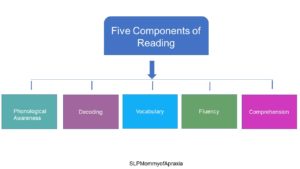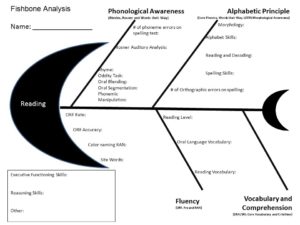SLP’s integral role in the five components of reading
When I was younger and learned to read, I remember I was taught phonics. I remember the phonics workbooks I had, and would read the rules at the bottom of the page for spelling. It was all very systematic. Little did I know at the time, phonics was just one part of the five components of reading that can contribute to reading disorders.
Today, a concept called whole language dominates our public education systems. Not every school district or school uses this approach, but very many of them do and it is at a detriment to our children who have reading disorders. Some critics go so far as to say whole language is “anti-phonics.” I don’t believe it’s quite that extreme. However, for kids who have reading disorders, the vast majority struggle with phonemic awareness and decoding, which a whole language curriculum is not even close to adequately addressing.
I’m fortunate that when I started my career, Ashlynn’s SLP was very knowledgeable on the topic. I had no idea that learning about the five components of reading before my child was even conceptualized would come back and benefit her some day.
So, what are the five components of reading?
They are: Phonemic Awareness, Decoding, Fluency, Vocabulary, and Comprehension. These areas were identified by the National Reading Panel that was convened by Congress in 1999. It’s very important that parents and educators are aware of these five components, because weaknesses in any one component can cause a child to struggle to read.
Speech/Language Pathologists can play a big role in reading. They are trained and certified to treat children with three of the five components. A Speech/Language Pathologist can work on phonemic awareness, vocabulary, and comprehension. This is why they are frequently on IEP’s when children have reading disorders. It is very infrequent that the older school-aged child with dyslexia is seeing the SLP to work on their “sounds.”
Parents and educators all need to be aware and familiar with these five components if they want to help children effectively who are struggling to read. During my time in Denver Public Schools, an excellent teacher advocated the use of a “fishbone” analysis when testing kids who were struggling to read.
As you can see, it contains the five components of reading, and spaces to document a child’s performance in all five areas. It could be possible to have a child who has difficulties in all of these areas. However, more frequently a couple of areas usually stand out. One area that is frequently a problem is with phonological awareness skills. This can be tricky because elementary school children many times get identified with a reading disorder past the time that instruction with phonological awareness is taught. Teachers jump right into reading instruction without realizing the child is lacking the basic building blocks for reading in the first place.
So what is phonological awareness?
Phonological awareness refers to a child’s ability to manipulate sounds out loud. Tasks included in this umbrella might be to identify the initial sound in a word, blend sounds, segment sounds, identify the last sound in a word, or be able to identify and formulate rhyming words. Logically it would make sense why this is a building block skill. If a child can’t do these things out loud, it’s going to be very difficult to transfer these skills when looking at graphemes (letters).
Phonics/Decoding
Phonics refers to the actual act of sounding out words. To do this skill, children need to have mastered knowing letters and letter sounds, and then be able to use this knowledge of letter sounds to “decode” a word.
Vocabulary
A child’s vocabulary many times affects background knowledge, which is important in reading. If the words they are trying to read hold no meaning due to low vocabulary skills, it is going to be harder for them to understand what they are reading. In addition, a child with weak vocabulary skills will have a harder time monitoring their comprehension when reading sentences. I see this all the time as an SLP. An example of this would be if a child were to read the sentence “He saw the dog.” Instead of “saw” he/she read “sam” and they would continue reading. Many children without a language disorder would realize “He sam the dog” didn’t make sense and go back and try and fix the sentence so that it makes sense. Kids with language disorders have a very difficult time with this skill.
Fluency
Fluency refers to a child’s ability to read text accurately and quickly while maintaining good expression. The ability for a child to read fluently helps with comprehension. If a child’s fluency is slow and choppy, they may be allocating so much brain power to decoding that they are not monitoring comprehension. If a child lacks expression in their reading, this too can affect comprehension.
Comprehension
Comprehension is simple terms, means understanding what we read. Kids with a mixed receptive/expressive language disorder or an auditory processing disorder frequently experience difficulties with text comprehension.
What does this mean for parents?
The bottom line for parents is that reading is a complicated process that has many components. A deficit in one or more of the above listed components can cause a child to struggle when learning how to read. Children with speech and language disorders are at high risk for reading disabilities. Being aware of all five components helps parents be more informed regarding treatment approaches and options their child may need to catch up in reading.
This article contains information from the National Reading Panel’s Findings
Laura Smith is a first and foremost a mom to two amazing children, one of which who carries a constellation of invisible labels including: Childhood Apraxia of Speech, dysarthria, SPD, ADHD, MERLD, dyspraxia, dyslexia, and cerebral palsy. She is a speech/language pathologist specializing in Childhood Apraxia of Speech following her daughter’s diagnosis. SLPMommyofApraxia is her space to share her professional and personal experiences related to the complex but beautiful world of neuro-diversity and to spread a message of hope, positivity, acceptance, and kindness.

